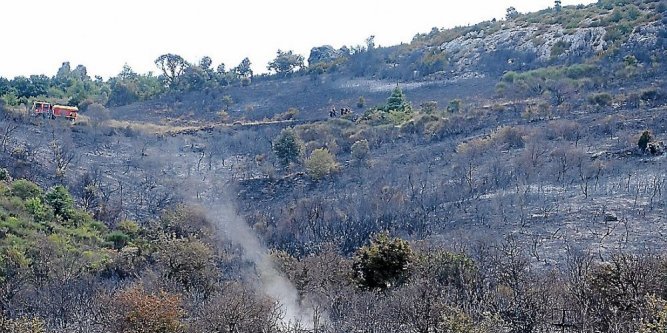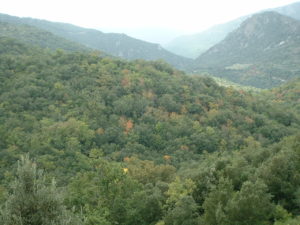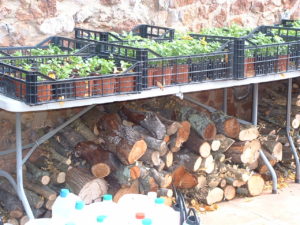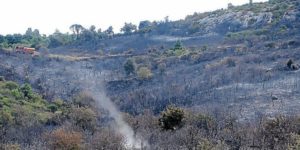Montrouch comprises of around 26 hectares of land on the side of Mont Tauch. Most of the land is hilly, with just the land around the buildings and a small patch around the solar panels being vaguely flat. The buildings themselves are on top,of a hillock, the site of an old castle or fortified hamlet, the records are not quite clear which. Of the 26 hectares 21 are garrigue forest and forest proper. The forest itself is young. Despite the fact that Tauch is Occitan for yew the forest is predominantly oak, both green and white oak, with some juniper and beech thrown in, and down by the stream beds a bit of ash. There are no longer any yews on Tauch.
As I said the forest is young, and like most of the Corbieres forest it is quite stunted, particularly at the top of the hills where water is in short supply. It is also quite dense, nature loathes a vacuum, and young trees and bushes fill the spaces in between the bigger trees. Peter McPhee in his great book, Revolution and Environment in Southern France, takes the reader through the devastating impact the French revolution has on the landscape of Les Corbieres. I am in the middle of re reading the book and will write a review later. Until then the potted story is that with the disappearance of Corbieres aristocracy the untendered land was pillaged, first by charcoal burners who cut down the trees to make charcoal for the forges that transformed the ore mined in Maisons and Palariac. After they had denuded the hillsides goats and sheep farmers grazed their flocks on the land. The top soil, which had been held in place by the tree roots could not withstand the autumn and winter rains, most was washed away to reveal the stony base we see now. Reel forward to the back end of the 19th century and the marginal agricultural land of the High started to fall into disuse. Mountainous subsistence farming, never very attractive in the first place, found that it could not compete with the increasingly mechanized farming of the plains. Land was left to re wild, first in the form of garrigue and then later as trees found the little nurture that remained as stubby forest.
As commercial forest most of the naturally developed forest of Les Corbieres is uneconomical; the trees are small and the land inaccessible. The Forestry Commission has replanted parts of the commune owned land with fast growing pine trees not native to this part of the world. While they grow the land underneath them is barren with little to no wildlife being supported by these plantations. In areas of the Corbieres with higher rainfall oaks an other slower growing trees have also been planted.
So what do we do with all our forest? Well not a lot to be honest, we are two people and 21
hectares of mountainous forest is a lot of forest. The first thing is fire wood, wood burning is our main source of heat in winter. Corbieres winters can be vicious. The Tramotane, the freezing Northern wind that can reach speeds in excess of 100kpm can cut right through you. Although even in winter our front door tends to remain open, as we and the dogs are constantly on the move. However when darkness falls the fire gets lit and the appero poured. We have a large jam making pot that sits on top of the fire and acts as a storage heater ensuring that the cold mornings are held at bay. Hot water bottles and duvets on the TV sofa help also.
The second reason for working the forest is to try and limit the dangers of wild fire. Last year the Tuchan side of Mont Tauch suffered a huge fire, 1,200 hectares of garrigue, forest and a few vines were destroyed in less than a day. This year we have already had two wild fires in Maisons. By law we have to cut down or prune to height of 2 metres the trees up to 50 metres from the house. I tend to prune the larger trees, cutting down just the small one. The shade is welcome in the summer, both by us and the plants. Being surrounded by trees also goes, a little, way to push the wind over us.
The third reason why I cut down trees is to support and help and the forest grow. It sounds kinda contradictory but the forest really benefits from being thinned out, as does the wild life that lives in the forest.
I use a method called thinning from below. The idea is to identify the strongest trees, prune them by cutting off low hanging branches and the smaller side shoots. The smaller trees around them get chopped down and turned into fire wood. This reduces the competition for the limited resources in the soil, it creates a more open habitat space for birds and wild life, and, if you clean away the felled brush, reduces the risk of fire.
The idea is to leave the Montrouch forest stronger, and hopefully taller than how we found it, with an increased level of biodiversity as well. A tall order and a lot of time with the chainsaw is required, but slowly we are getting there.




